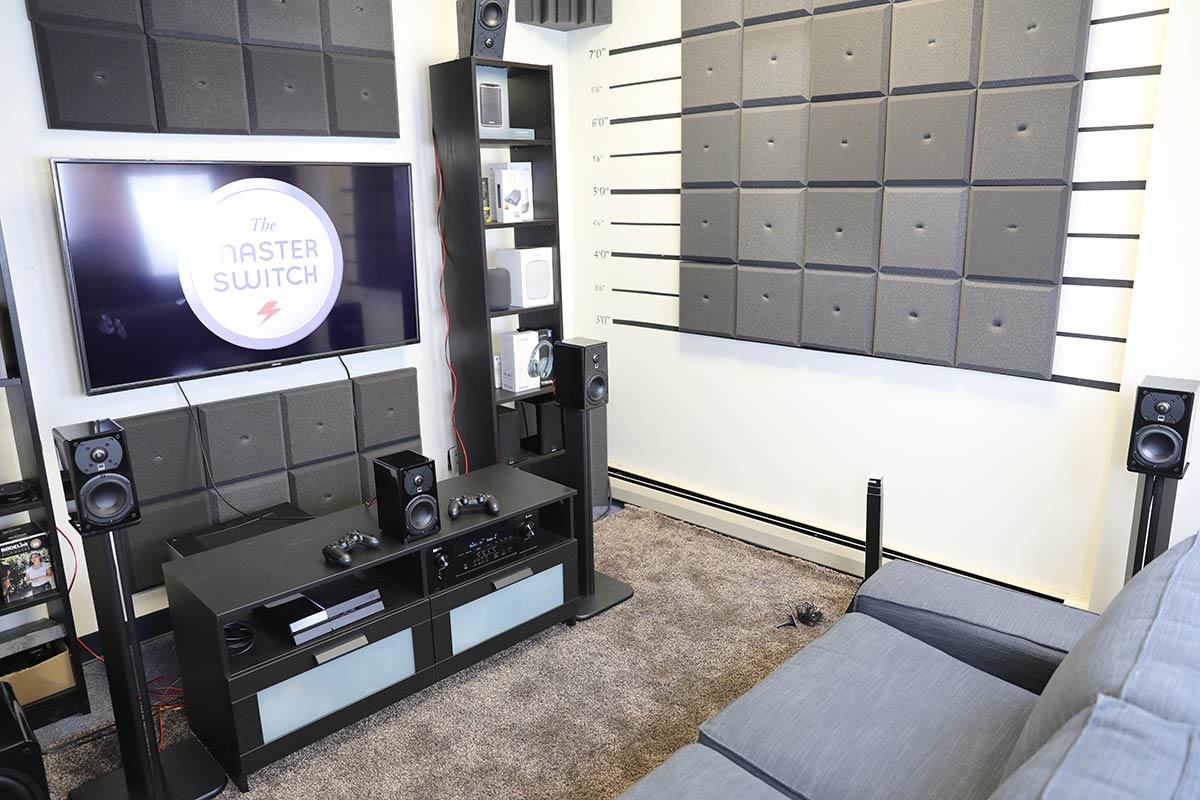
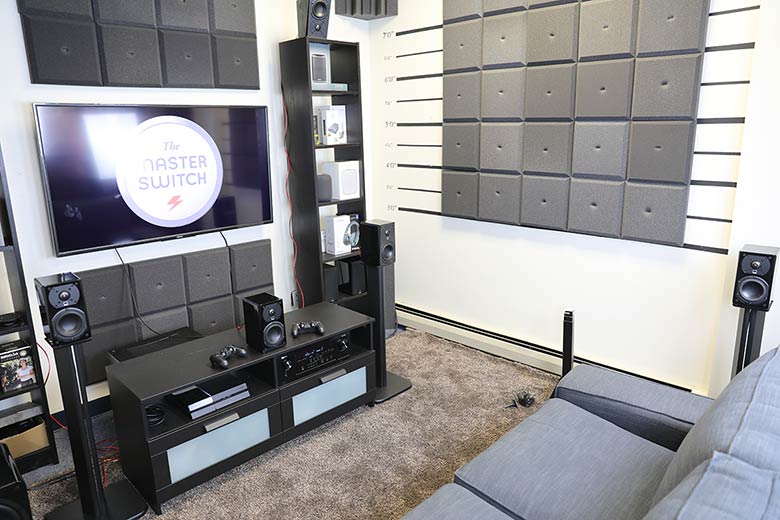
The Master Switch


The Master Switch
The 5.1-channel surround audio system has been around for two decades now, and has become the absolute standard for home theaters. But if you go up to the luckier-sounding 7.1 surround system, the cinematic audio experience is delivered through seven speakers and a subwoofer. What this bigger set does to the audio ambience is substantial, and the improvements to the directionality and continuity of the sound are immediately noticeable. Note that these are complete systems, rather than mixed-and-matched speakers. To complete your setup, check out our list of the best AV receivers.
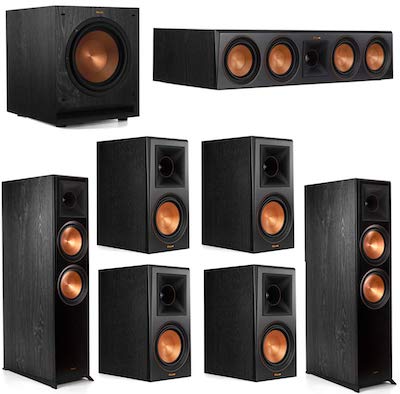 Receiver Wattage: 105/8Ω, 2Ch Driven
Receiver Wattage: 105/8Ω, 2Ch Driven
Surround Tech: Dolby (Various), DTS (Various)
Expandable To: 9.2
What We Like: Superb, world-beating sound quality.
What We Don't: Klipsch frequently cycle their packages, leading to availability issues.
If you want the absolute best in 7.1 surround sound, then there is only one name you need to be looking at, and that’s Klipsch. They make the best surround home theatre packages we’ve ever heard, and this one—a 7.1 system anchored by the gigantic RP-8000F floorstanding speakers— is out of this world. The audio quality is rich and sumptuous, with enough power behind it to rattle the walls of your cave. Compared to other systems from the likes of Aperion and Martin Logan, there’s simply no contest. The 7.1 system on offer here is certainly expensive, but it’s absolutely worth the money.
The biggest downside is that we cannot say how long this package will be available for. Klipsch have a singularly irritating habit of regularly cycling their packages, and their unfriendly product names make it very hard to nail down exactly which one you want. While there will almost always be a comparable system from the company available, it won’t be this exact system, which really is outstanding. We’ve paired it with the pulse pounding Denon AVR-X3700H receiver, which will extract the best out of the Dolby Atmos modules embedded in those massive speakers. It’s a highly recommended combination.
See the Klipsch 7.1 System See the Denon AVR-X3700H
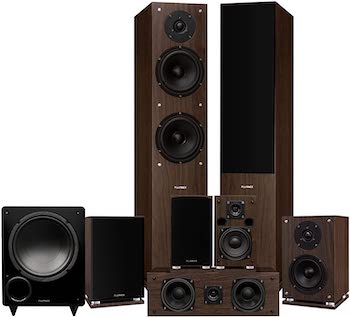 Receiver Wattage: 90/8Ω, 2Ch Driven
Receiver Wattage: 90/8Ω, 2Ch Driven
Surround Tech: Dolby Atmos, DTS:X
Expandable To: N/A
What We Like: Crisp, realistic sound quality for under $1,300.
What We Don’t: Speaker design is very old-school.
Fluance are one of the few manufacturers who still devote time to dedicated 7.1 speaker systems, so it’s hardly surprising that they have more than one entry on this list. The Elite Series isn’t quite as good as the top-ranked Signature Series, but it’s also significantly cheaper, and doesn’t compromise on sound quality. The audio is crisp and realistic, and excels at delivering great detail. You’ll have to deal with the fact that the speakers look like they come straight out of the 1970s, but if you can excuse that, you’ll find that the Elite Series is among the best speaker systems you can buy for under $1,000.
We always been of the opinion that Pioneer and Integra receivers work particularly well with Fluance systems, and we are happy to add those from Yamaha to that list. Our particular pick in this case is the excellent RX-V685, a simple and relatively affordable receiver that gets the job done, without costing the earth. While it does have some downsides, including only four HDMI ports, we think it’s one of the best affordable options available the Fluance speaker system.
See the Fluance Elite Series See the Yamaha RX-V6A
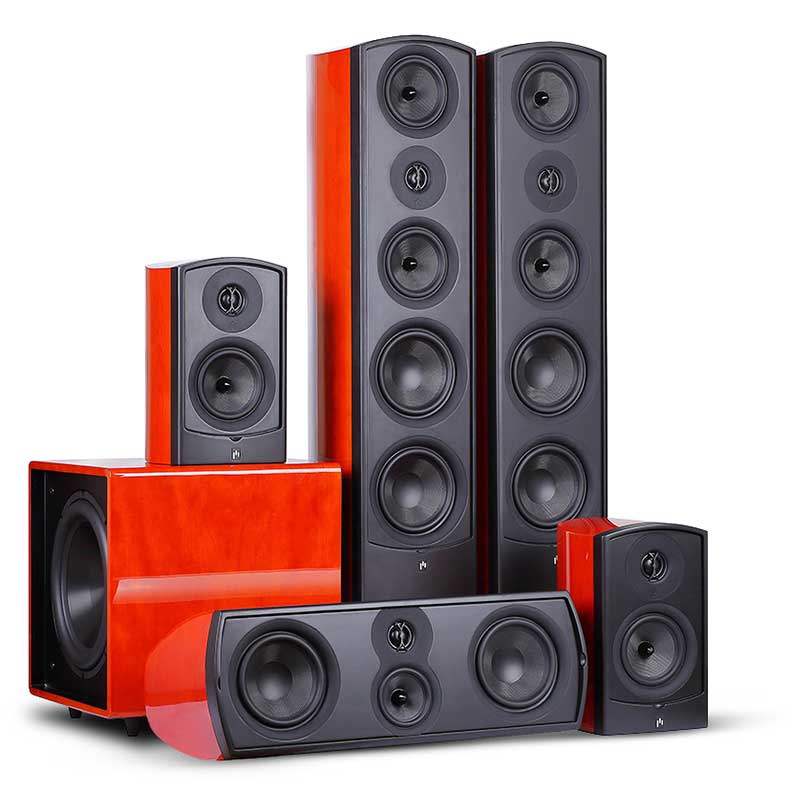 Receiver Wattage: 110/8Ω, 2Ch Driven
Receiver Wattage: 110/8Ω, 2Ch Driven
Surround Tech: Dolby Atmos, DTS Master Audio
Expandable To: 9.2
What We Like: Splendid audio combination - NAD and Aperion together are a real win.
What We Don’t: Lack of specs makes pairing tricky.
Aperion Audio makes absolutely tremendous home theater gear. The new speakers in the Verus III range have redesigned tweeters and tweaked crossovers, giving them even more crisp detail. This spot on the list was previously held by the KEF R Series, but that's no longer offered as a package. The Verus III can go head to head with more expensive speaker systems from Klipsch and Martin Logan, below, and although it’s expensive, the Verus package crushes it. While we've highlighted the 10D version here, which we think is the best, it also happens to be the most expensive model they offer. However, there are plenty of variations, if you want to spend slightly less.
When you pair these speakers with NAD's T 778, magic happens. The T 778, while occasionally a little tricky to find – it’s still new at the time of writing – is a superb AV receiver. It goes beyond simply being a big black box with cable connections, displaying a user interface on a fantastic color touchscreen. We also think it pairs beautifully with the Aperion system and, if you can score yourself these speakers along with the T 778, you’ll have a system you can truly be proud of. You will definitely pay for this combination, but it's a great one, and worthy of a place on this list. We do, however, wish that Aperion had thought to release more specs. We’d like to know the wattage range of the speakers and their frequencies.
See the Aperion Audio Verus III Grand Tower Surround 10D See the NAD T 778
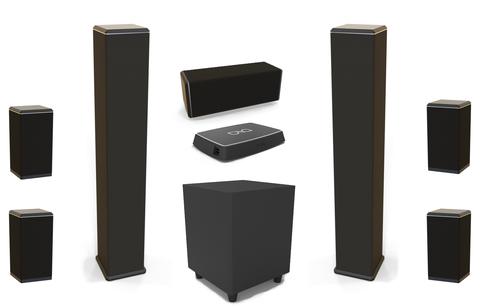 Receiver Wattage: N/A
Receiver Wattage: N/A
Surround Tech: None
Expandable To: N/A
What We Like: The ultimate in convenient sound, easy to setup and use.
What We Don't: Wired systems have better audio, the pricetag is hefty, no Atmos or DTS:X.
Money doesn't always buy convenience. Ask anybody who has to setup a five-figure system, and you'll be bored to tears hearing them talk about power supplies, dedicated DACs, and how they personally keep speaker wire companies afloat. Axiim have done away with all that, with their new 7.1 WM Series release. It's a mostly wireless home theater system that both looks and sounds fantastic, and deserves its crown here.
The drawback is that you have to plug each speaker into the mains, meaning you'll need eight power cords - seven for the speakers, plus one for the sub, and eight outlets to connect them up to. Since they're likely to be at opposite sides of the room, you'll need a large space, or lots of extension cords. You also won't be able to upgrade later with speakers from other companies, and you'll have to pay a sizeable amount for the privilege. The sound also doesn't touch the Aperion combo, at the top of this list, which beats it on detail and energy. But what you're paying for here is a home theater room without wires, and we've rarely seen such a system - even by folks like Sonos - done with this much panache. Flawed, but still brilliant.
See the Axiim 7.1 WM Series
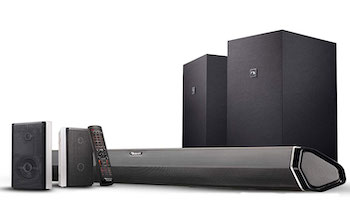 Receiver Wattage: N/A
Receiver Wattage: N/A
Surround Tech: Dolby Atmos, DTS:X
Expandable To: N/A
What We Like: Unreal sound quality, convenience.
What We Don’t: Clunky controls and remote.
Until recently, this position on the list was occupied by the Nakamichi Shockwafe Elite soundbar. We can’t find that model for sale anywhere at the moment, so we replaced it with the Nakamichi Shockwafe Pro 7.1 DTS-X/Atmos. It’s a slightly stripped down version that still manages to be the soundbar option for 7.1 surround. We think it’s a better option than the similarly priced JBL Bar 9.1, and definitely a better option than the Sonos Surround Set, although it lacks that models wireless capability.
While the Nakamichi Shockwafe Pro 7.1 is undoubtedly convenient, it does have some issues. Chief among these is the remote, which is clunky and unintuitive, and this extends to the rest of the controls. There’s also no way to add additional speakers, meaning that unlike standard 7.1 systems, it’s not possible to upgrade with additional channels. That’s unfortunate, but it’s not a deal breaker. If you want a convenient soundbar solution for your home theatre, look no further.
See the Nakamichi Shockwafe Pro 7.1 DTS-X/Atmos
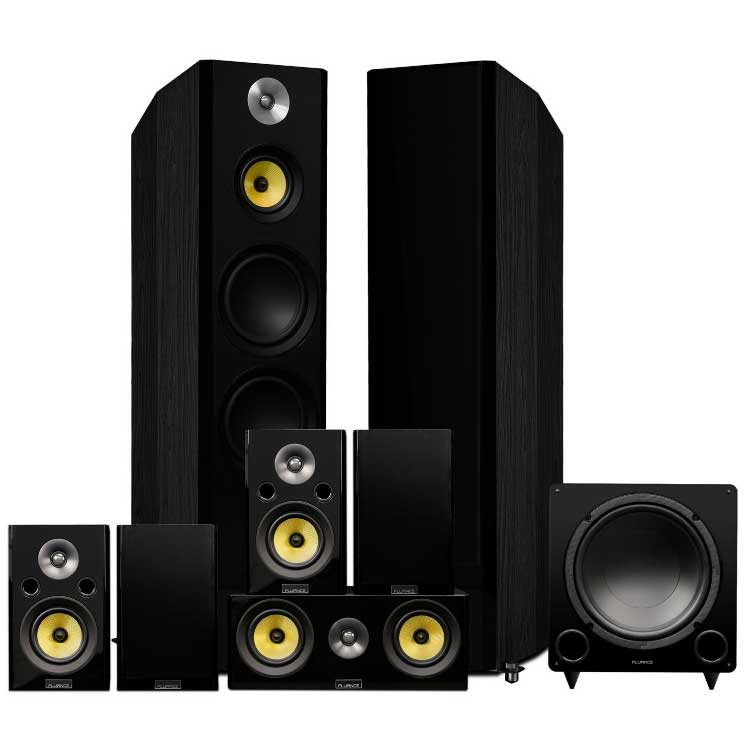 Receiver Wattage: 90/8Ω, 2Ch Driven
Receiver Wattage: 90/8Ω, 2Ch Driven
Surround Tech: Dolby Atmos, DTS:X
Expandable To: 9.2
What We Like: Fluance and Yamaha work really well together.
What We Don't: No included subwoofer, which means there’s an extra component to buy.
The Fluance Reference Series is technically a 7.0 system, rather than a 7.1. But at this price, you could quite happily spend another grand on a good subwoofer and still be ahead of the game. The Signature Series is an upgrade to the old Reference Series, and it's a real jump in quality. Be aware that it costs roughly $460 more than the previous model, meaning this combo isn't as budget-friendly as we'd like. The Sony STR-DN1080 7.2, below, is a more complete package. The lack of a subwoofer means that the Fluance does lose out to the Klipsch system, above, although it’s still excellent in terms of audio quality.
Let’s talk receiver pairings. One of the main reasons we like the Integra DRX-3.3 Is that it really does bring out the nuance in the Fluance (so to speak) delivering excellent detail and supple variations in the sound. That means, for under $3,000, you have one of the most versatile and flexible audio landscapes in home theater. It also hardly needs pointing out that the Integra receiver has twin subwoofer outputs, meaning you can augment the 7.2 Fluance system. And by the way, if you decide to switch to wireless speakers from the likes of Sonos later (one of their systems as reviewed below) you can always use the Integra, which is fully integrated this kind of wireless audio.
See the Fluance Signature Series See the Integra DRX-3.3
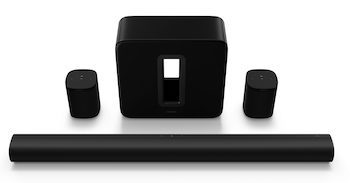 Receiver Wattage: N/A
Receiver Wattage: N/A
Surround Tech: Dolby Atmos
Expandable To: N/A
What We Like: Amazingly easy to use, with solid sound quality.
What We Don’t: Impossible to upgrade later.
This entry is technically cheating. The Sonos Surround Set is marketed as a 5.1 system, rather than a traditional 7.1. But it is, in fact, hiding a 7.1 system inside its sleek housing. It can handle full Dolby Atmos, and included Arc soundbar contains two upward firing speakers, meaning we can add it here. We want to anyway, because it’s terrific. It delivers solid if occasionally unspectacular sound quality, and is amazingly simple to use. Pound for pound, we don’t think you’ll find an easier system to set up than the Sonos Surround Set.
There are some downsides to the Surround Set. It’s impossible to upgrade later by adding additional speakers— something that it has in common with other sandbar systems, but which is still vexing. And ultimately, it is beaten by other less expensive soundbar packages on sound quality. The Nakamichi Shockwafe, For example, clocks in at under $1000 and sounds much better. It can’t match the Sonos for ease of use though…
See the Sonos Surround Set
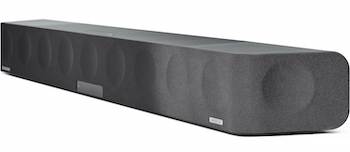 Receiver Wattage: N/A
Receiver Wattage: N/A
Surround Tech: Dolby Atmos, DTS:X
Expandable To: N/A
What We Like: Wonderful height audio makes this bar perfect for Dolby Atmos
What We Don’t: Demands a big room to get the best out of.
If you have a large living room (say, over 250 square feet), but you don’t want to clutter it up with multiple speakers and speaker wire, it may be worth checking out the Sennheiser Ambeo soundbar. While it’s expensive— far more than something like the Nakamichi bar, above— it lends itself to large rooms that can take its huge sound. We particularly love what it does with height audio, managing to create a convincing image without the use of additional satellite speakers.
Unfortunately, if you don’t have a big room, or a couple thousand dollars to spare, then the Sennheiser Ambeo may not be the soundbar for you. In small environments, that wonderful height audio and surroundsound comes off as constrained and boxed in. That’s a shame, but fortunately, there are several other alternatives, including the aforementioned Nakamichi, and sets from Sonos and JBL.
See the Sennheiser Ambeo
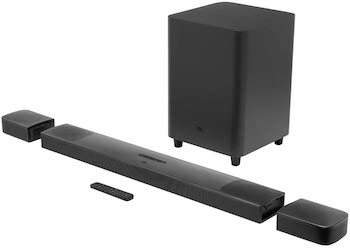 Receiver Wattage: N/A
Receiver Wattage: N/A
Surround Tech: Dolby Atmos, DTS:X
Expandable To: N/A
What We Like: Good bass and detail on offer.
What We Don’t: Arguably the least-effective Atmos bar of the options here.
JBL are something of a dark horse in the world of surround sound systems, but their Bar 9.1 is a way to rectify that. It offers a full nine channels of audio, contained in a soundbar plus two satellite speakers and a subwoofer. We appreciated just how much punch the audio had, especially download, and the way the speakers translated detail was excellent. Unlike the more expensive Sonos Surround Set, there’s full access to DTS:X as well as Dolby Atmos. If you happen to be partial to the former, then the Bar 9.1 is a solid option.
The problem is, it doesn’t quite do enough to put itself in front out of its competitors. The Nakamichi Shockwafe is identically priced, but does a much better job of Dolby Atmos, and surround sound in general. In fact, among the sound bar options on this list, we found that the Bar 9.1 is arguably the least effective in terms of positioning and realism. That’s a shame, but it doesn’t stop the Bar 9.1 from being a good second option.
See the JBL Bar 9.1
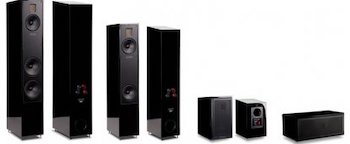 Receiver Wattage: 140/8Ω, 2Ch Driven
Receiver Wattage: 140/8Ω, 2Ch Driven
Surround Tech: Dolby Atmos, DTS:X
Expandable To: 11.2
What We Like: Two companies working in perfect synergy.
What We Don’t: Not too much for this price!
One of the things we set out to do when writing this piece was to see if we could include all the big speaker-makers—surprisingly tricky, as not all of them offer complete packages (SVS, for example, only offer a 5.1 package). That's not a problem for sister companies MartinLogan and Anthem. MartinLogan offer a dedicated setup they call the Ultimate, and while we don't think it beats the Klipsch and Aperion options, it's still incredible. The audio is incredibly detailed and textured, particularly the bass, which is served by the company's top-of-the-line Dynamo 1500X subwoofer.
To go with it, we'd recommend a receiver from Anthem. As part of the stable of companies, the engineers will work closely together, and these two elements absolutely sing. The MRX1120 may have slightly limited codec support, but what it does offer is Anthem's famed Room Correction, expertly tuning the speaker system to your room. And besides, this goes up to 11.2 channels if you ever decide to go really big. Go on: you know you want to.
See the MartinLogan Motion 7.1 Ultimate See the Anthem MRX 1120
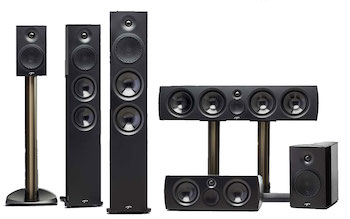 Receiver Wattage: 140/8Ω, 2Ch Driven
Receiver Wattage: 140/8Ω, 2Ch Driven
Surround Tech: Dolby Atmos, DTS:X, Auro3D
Expandable To: 11.2
What We Like: One of the few packages Paradigm offers—and it's a beast.
What We Don't: Value-for-money isn't quite there.
Paradigm really shine when you start mixing and matching separates - they have a huge catalogue, and for home theater fans, it can be a lot of fun constructing a dream system. The relatively new Premier Series is a chance to build one from matched components. Don't be fooled by the mix-and-match interface on their website; it's easy to build a system as big or as small as you want, and it'll sound amazing - although, you'll need to add a subwoofer. Paradigm are known for their thick, powerful bass, and this system really delivers on that.
Speakers this weighty need a beast of a receiver, and we think the epic Marantz SR8012 is the one to go for. Yes, it's expensive - arguably more than it needs to be - but it pairs well with the Paradigm system, and offers a smorgasbord of surround sound codecs and features. Plus, you can always choose a slightly less expensive receiver - the NAD T 778, perhaps - and save a bit of cash. This system matches up well against the MartinLogan speakers, above, even if can’t bost quite the same audio detail.
See the Paradigm Premier Series See the Marantz SR8012
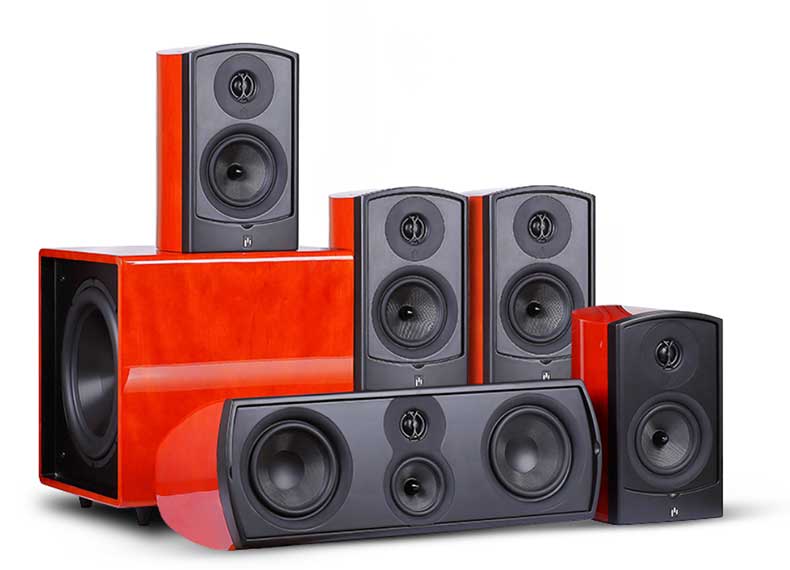 Receiver Wattage: 75/8Ω, 2Ch Driven
Receiver Wattage: 75/8Ω, 2Ch Driven
Surround Tech: Dolby Atmos, DTS:X
Expandable To: N/A
What We Like: A great way to experience Aperion at a relatively decent price.
What We Don't: Beaten out by other systems.
We hemmed and hawed about whether or not to put a second Aperion system on this list. But their speakers perform so well that we wanted to highlight another package. Even if it isn't quite as good as the more affordable Fluance / Onkyo combo above, and doesn't even come close to their amazing Verus II system, the Grand Bookshelf Harmony 12D system is superb. Despite the Bookshelf in its name, this isn't a hi-fi system; it comes in 5.1 and 7.1 variations, and is clearly designed for smaller rooms where bookshelf speakers would be better than floorstanders. The sound is outstanding, with great detail and imaging.
We were also quite surprised at how well the system paired with the Denon AVR-X4700H. In our experience, Denon products don’t always pair well with bookshelf speakers, for whatever reason, but this was a clear exception. They are a good pairing, and worth your time.
See the Aperion Verus III Grand Bookshelf Harmony 12D See the Denon AVR-X4500H
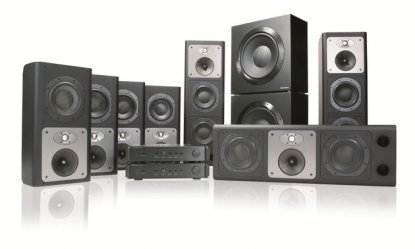 Receiver Wattage: N/A
Receiver Wattage: N/A
Surround Tech: N/A
Expandable To: N/A
What We Like: Arguably the most powerful home theater package on the planet.
What We Don’t: Only millionaires need apply.
Well, what did you expect? This is such an expensive package (custom installs only, if you please) that it's really only to be considered a high-end option. But oh man, does it sound good. We've only ever heard it at audio shows, and then only once, but…damn.
It's actually designed to be a 7.3 channel system, which is crazy rare, and requires all sorts of additional components (switchers, power supplies, bespoke cables) to get the best out of it. You'll notice how we haven't actually recommended a receiver for this one. That's deliberate - firstly, we're not sure we're capable of making that choice, which is something best left up to whichever B&W engineer visits your man cave to install this thing, and secondly, because we're not sure a single-box receiver exists that could handle it! At a push, we'd pair this with some Krell separates, but it's a big push.
See the Bowers & Wilkins CT800
Usually, we’d just have one table, but in this case, we’ve got one for speakers and one for receivers.
Speakers are up first. Note that the values for Freq refer to the lowest and highest frequencies all speakers in a system can reach, and RAP refers to Recommended Amp Power.
| System | Price | RAP | Lowest Freq | Highest Freq |
|---|---|---|---|---|
| Klipsch 7.1 System | $3,844 | 75-600W/8Ω | 35Hz | 25kHz |
| Fluance Elite Series | $875 | 30-160W/8Ω | 49Hz | 20kHz |
| Aperion Verus III Grand | $5,451 | Unavailable | Unavailable | Unavailable |
| Axiim 7.1 WM Series | $4,536 | N/A | 20Hz | 20Hz |
| Nakamichi Shockwafe Pro | $650 | N/A | 35Hz | 22kHz |
| Fluance Signature Series | $1,675 | 30-200W/8Ω | Unavailable | Unavailable |
| Sonos Surround Set | $2,096 | N/A | Unavailable | Unavailable |
| Sennheiser Ambeo | $2,500 | N/A | 30Hz | 20kHz |
| JBL Bar 9.1 | $1,000 | N/A | 34Hz | 20kHz |
| MartinLogan Motion 7.1 | $7,095 | 20-440W/4Ω | 20Hz | 25kHz |
| Paradigm Premier Series | $5,500 | 15-180W/8Ω | 53Hz | 22kHz |
| Aperion Verus III GB | $4,145 | Unavailable | Unavailable | Unavailable |
| Klipsch RP-250F 7.1 | $2,795 | 100-400W/8Ω | 35Hz | 25kHz |
| Bowers & Wilkins CT800 | $90,000 | Unavailable | Unavailable | Unavailable |
And then the receivers. 'Inc' under the Price section means it's included in the speaker package above. Exp. refers to the number of channels a receiver can be expanded to; Conn. refers to its connectivity.
| Receiver | Price | Wattage | Surround | Exp. | Conn. |
|---|---|---|---|---|---|
| Denon AVR-X3700H | $1,199 | 105W/8Ω - 2Ch | Dolby (Various), DTS (Various) | 9.2 | Blue./Wi-Fi |
| Yamaha RX-V6A | $800 | 100W/8Ω - 2Ch | Dolby (Various), DTS (Various) | N/A | Blue./Wi-Fi |
| NAD T 778 | $3,199 | 110W/8Ω - 2ch | Dolby Atmos, DTS Master Audio | 9.2 | Blue./Wi-Fi |
| Integra DRX-3.3 | $999 | 90W/8Ω - 2Ch | Dolby (Various), DTS (Various) | 9.2 | Blue./Wi-Fi |
| Sony STRDN1080 | Inc. | Unknown | Dolby Atmos, DTS:X | N/A | Blue./Wi-Fi |
| Denon AVR-X1300W | Inc. | 80W/8Ω - 2ch | Dolby Atmos, DTS:X | N/A | Blue./Wi-Fi |
| Anthem MRX 1120 | $3,499 | 140W/8Ω - 2ch | Dolby Atmos, DTS:X | 11.2 | Wi-Fi |
| Marantz SR8012 | $2,999 | 140W/8Ω - 2ch | Dolby / DTS (Various), Auro3D | 11.2 | Blue./Wi-Fi |
| Denon AVR-X4700H | $1,499 | 165W/8Ω - 2ch | Dolby (Various), DTS (Various) | 11.4 | Blue./Wi-Fi |
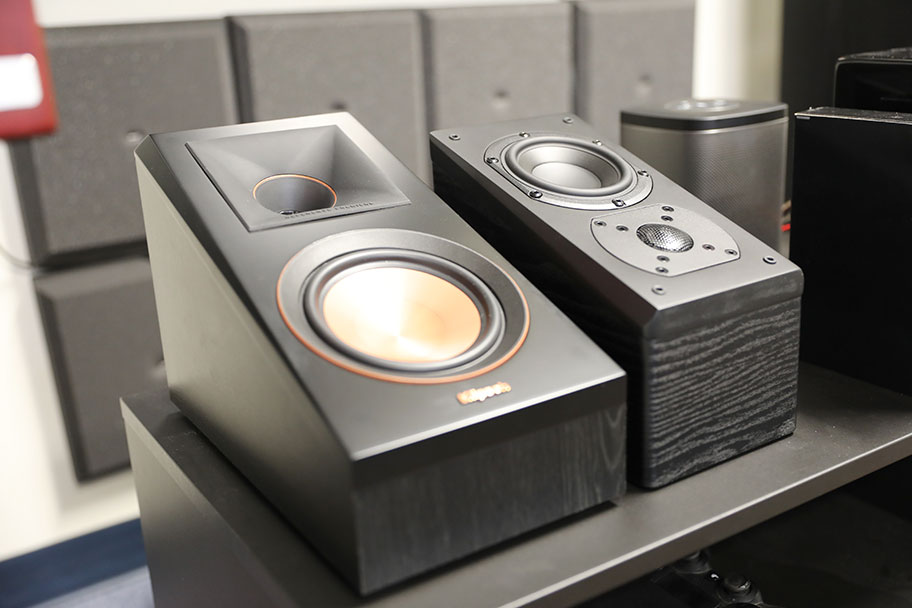
A 7.1 surround system is a home entertainment package consisting of seven speakers and one subwoofer, connected to an AV receiver with the right credentials - namely, enough separate speaker connections and wattage to power everything. The receiver acts as the main hub where all audio and visual sources such as Blu-ray/DVD players, game consoles, computers and wireless streaming are being connected into, and the speakers…well, they make noise. From the front, back, and sides, as well as shaking your stomach with bass. (If you want a guide to the big differences between 5.1 and 7.1, check this out.)
The receiver is linked to your TV screen (or two or three, depending on the receiver's specs) as well as decoding (or translating) audio data into surround sound playback, where sounds can freely 'hover' between the surround speakers. On rarer occasions you may find the same setup but with a separate power amp and receiver, which is the kind of thing that only dedicated audio fiends get into. It's a bit much for our purposes here though! As with any other technology, the quality of 7.1 system can vary depending on cost. You can find 7.1 systems from as little as a couple of hundred bucks these days. Cheaper setups will still let you experience surround sound motion, but many have very limited connectivity. And such entry level sound quality is quite comparable to a glorified ghetto blaster, really. Oh, and if the idea of seven-plus speakers makes you break out in hives, don't worry. We've got a full guide to all the connections you'll need to get things up and running.
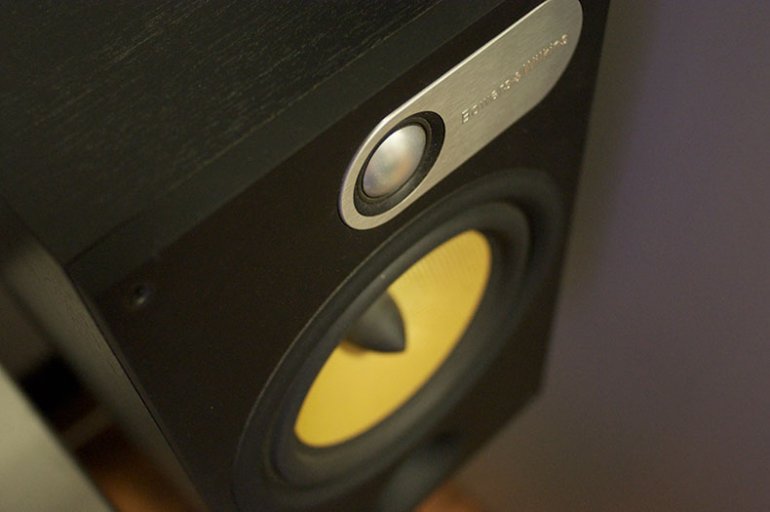
One of the best ways to put together a 7.1 system is to mix and match individual components from different companies: satellites from one, sub from another, floorstanding speakers from a third. We can't really list those here; each room and listening situation is different, and listing individual components would make this roundup unwieldy as hell. What we've done instead is focus on companies that offer 7.1 'packages' - sets of matched speakers, ready to go. Where indicated, we've paired these packages with a good receiver. In our mind, this is by far the simplest method of doing this, even if it does mean that excellent companies like Phase, Harman Kardon or SVS don't make the list. Those companies, unfortunately, don't offer dedicated 7.1 packages for purchase - although their individual components feature on plenty of other product roundups on this site, and we'd absolutely recommend them if you go the component route. Our approach does mean that some companies do dominate. To make things easier, we've broken down our picks into handy categories - no matter what your budget, we've got something for you.
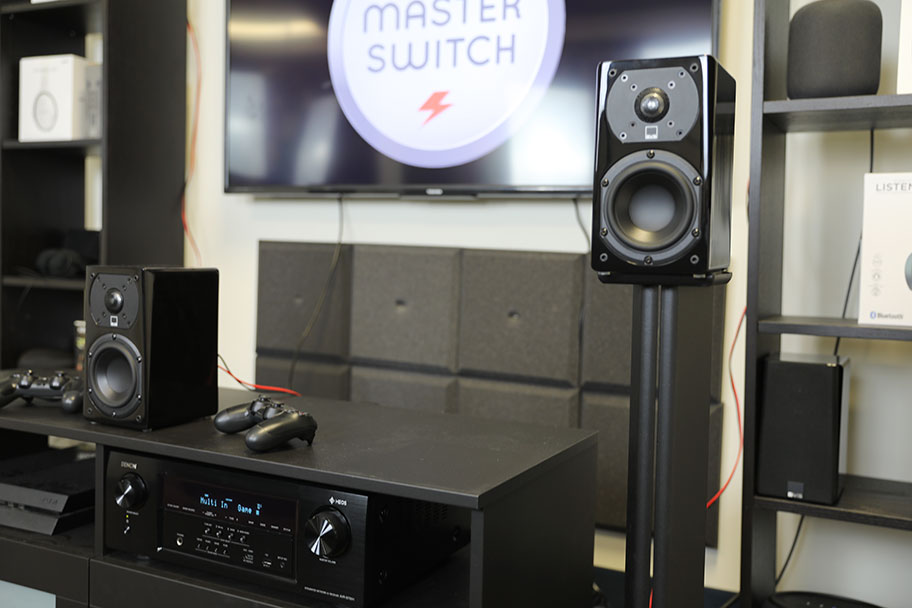
Let’s say you’ve already installed your 7.1 surround system. That’s your starting setup. What if you wanted to go bigger? What, you thought we’d just stop at seven? Nah, man. You can add a second subwoofer if you really want monster bass, making it into a 7.2 system setup (where the number after the ‘point’ represents the subwoofer). This is easy enough - almost all receivers will be able to send audio to two subs, and then all you need to do is plug them into the mains. Larger-format surround systems can also be split into zones (different rooms). If you had your kitchen next to the movie room, you could actually kit it out with a pair of stereo speakers and subwoofer (2.1) while leaving the remaining 5 speakers and the second subwoofer to act as a regular 5.1 in your main room - both zones would be powered by the same 7.2 receiver. In that way you can ‘keep up’ with the movie, while preparing dinner or having a chat on the phone. That is a thing you could do.
But let’s say you want to go bigger. It’s worth investigating 9.1 and up. To do this, you need to use what are known as matrix sound channels. If that sounds complicated, all you have to know is that the original seven channels (and one sub channel) from the back of your receiver are all discrete channels that carry an independent signal, whereas a matrix channel actually blends some of this audio, helped along by the surround sound codec to translate it for a height speaker. Because that’s what 9.1 and 11.1 (or 9.2 and 11.2, if you have two subwoofers apiece) are. They involve height speakers.
If you only have two, taking the system to 9.1, you would place these either above you and on either side of your listening position, or above your front speakers. If you had an 11.1 system, you would have speakers in all four positions, or alternatively, in the corners of the room. If you wanted to get this effect, then look at the Paradigm Premier Series system paired with the Marantz SR8012 receiver, which will take you all the way up to 11.2 channels for a little over $9,000, plus change for some additional speakers (the Paradigm website lets you buy as many or as few speakers as you need, allowing you to customize your system). You can, by the way, keep increasing the channels, but you need specialized equipment to do so, not to mention an absolutely massive room. We’ll talk about that a little more in the next section.
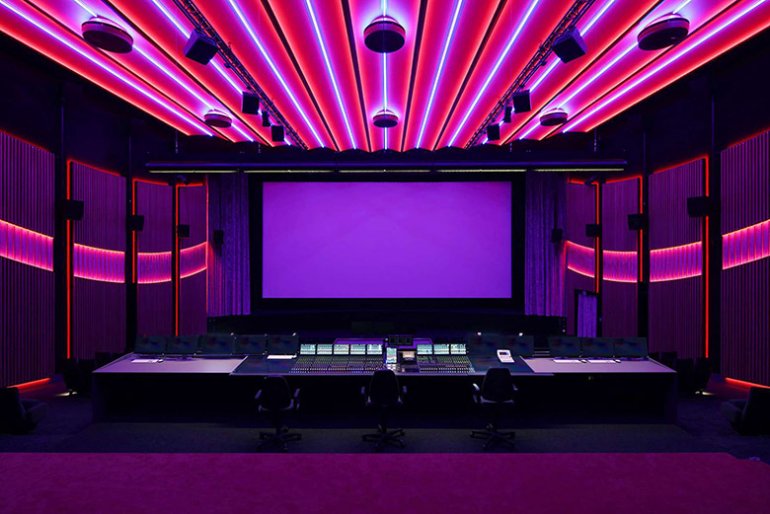
Dolby, DTS and Auro3D are the three big surround sound companies you need to know about. They make what are known as surround sound codecs: complicated software programs which take the sound source and use special algorithms to create a lifelike surround sound experience. While each of the companies has quite a few different codecs on offer, there are only three you really need to worry about. We are going to take each one of them in turn.
This is probably the most common. Chances are if you’ve been in a movie theater in the past five years, you’ve heard this one. It’s a very big dog it uses what is known as object-based surround sound: instead of sending a sound to a certain channel just because that’s what it’s mixed as, it uses, located programming tricks to blend the sounds together, placing each one of them indistinct, predetermined positions around the room by mixing them between the speakers.
To get your Dolby Atmos system working, you need one of several things. You need a set of height speakers (ideally, four) along with rear ones, a set of speakers that are angled upwards to fire their audio off the ceiling, or a set of modules that you place on top of existing speakers. Either way, if you want to take full advantage of this, you need quite a bit more speakers than a basic 7.1 system. The good news: even if you don’t have the space or budget for this, your 7.1 system can still take advantage of plenty of other Dolby codecs. By the way, Dolby often refers to their systems as 7.1.4, or 9.2.4. These are functionally the same as 11.1 or 13.2 systems - a bunch of ear-level speakers with four added height speakers. Don’t let the numbers get you down.
The thing about Dolby Atmos is that it absolutely requires height speakers to work. The thing about DTS:X is that it doesn't. It's a software codec that works with just about any speaker setup you can imagine. While it doesn't have quite the positioning capabilities of a full Dolby Atmos system, it still manages to eke some terrific imaging out of even a basic 5.1 system. You also don't need special hardware: in many cases, the DTS codec can be downloaded to a receiver as a software update, which is awfully handy. Having height speakers definitely improves things dramatically. But all the same, this is a very useful codec to have. It should be pointed out that almost all receivers these days come with both Dolby Atmos and DTS:X built in, so you shouldn't even have to choose. Interestingly, several of the setups in our list of the best 5.1 speaker systems use DTS:X, and are perfect for smaller rooms.
This is kind of a strange one – and even though it’s been out for a while, it hasn’t really managed to make significant inroads into the market held by Atmos and DTS:X. Unlike Dolby’s codec, which relies on object-based sound, Auro-3D is all about the channels. It what you go for if you have not only the space for multiple height speakers, but also a speaker known as the Voice Of God - how cool? - which is installed in the ceiling directly over your listening position. You don’t absolutely have to have this to use Auro-3D, but you do have to have at the very least a 9.1 system. There’s no denying that Auro-3D is amazing. We think it’s on par with Dolby’s codec, and in many cases, goes beyond it. But it’s still very much a dark horse in this particular race. If you do want to check it out, more and more receivers are including option for it, often in the form of an upgrade (which you’ll pay for). The Marantz SR8012 is a perfect example.
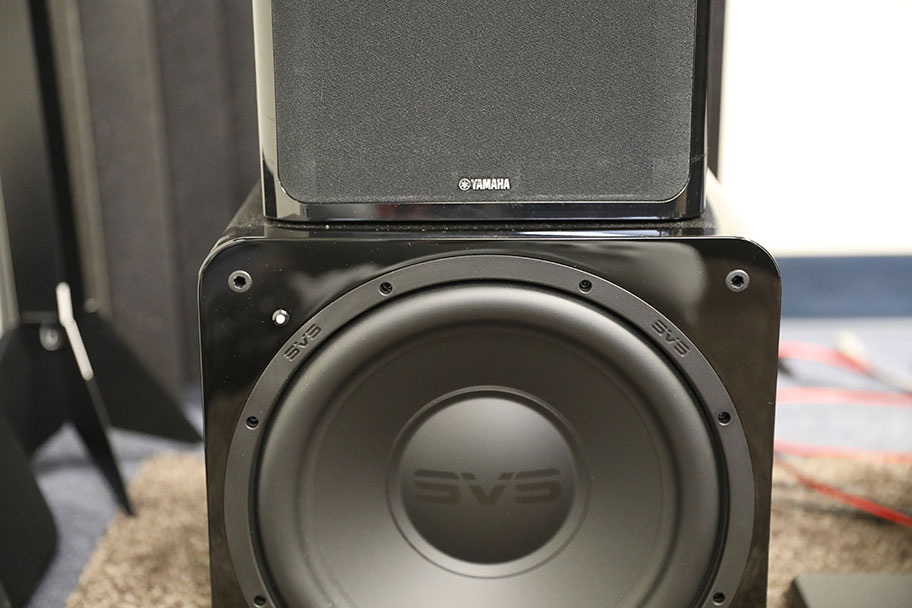
A quick refresher: speaker sets for 7.1. surround systems include a center channel speaker, left and right front channel speakers, a subwoofer, left and right surround speakers and left and right rear surround speakers. We'll steer clear of 9.1 and 11.1 systems here.
The rear surround speakers help to fill larger rooms more completely and add more depth to the experience by spreading the sound across four speakers rather than two (as found in 5.1 surround), resulting in more directed, immersive sound. The idea is to surround your listening position with speakers, putting the center channel, front channel and subwoofer in front of you, the left and right speakers on…well, your left and right, and the rear speakers behind you. Generally, you're supposed to elevate these, but that isn't always possible, so let's break down placement of a basic system. Chances are, you got some idea of where to put it all, because you have a brain. But that isn't really the point, is it? The point is to put it not just in the appropriate place, but in the best place. And finding that takes a little doing.
Let's assume for the moment that you have all three types of speakers knocking around. Let's start with the easy bits: the floorstanding speakers. These go, as your probably shocked to hear, on the floor, usually on either side of the TV. The exact placement of these is largely dependent on the shape of your room, but you want them in a rough triangle with the place you're going to be sitting. They should be roughly equidistant, and shouldn't be too close to walls or corners, which can lead to their bass frequencies getting a little muddled.
Next up, the subwoofer. The received wisdom is to put the thing underneath or next to the TV, but there's actually a little trick you can use to find the best place to put it. Wire up the subwoofer (and we'll talk about wiring in the section below) then put it in the place where you'll be sitting. Find something bass heavy. A track by Skrillex or Diplo would be ideal. Start playing, then crawl around the room at floor level. Yes, we know you look ridiculous, but there is a purpose to this, we promise. Find a spot in the room where the bass sounds the best, where it sounds as it's meant to. That's where you want to put your sub. This trick isn't completely full proof, and again, largely depends on the size of your room, but it's still very useful tool to have in your arsenal.
The easiest one of these to place is the center speaker, which should be labelled as such. Put it in front of or just underneath your TV. Job done. Next, check out the front left and right speakers, which, again, should be labelled clearly. These are quite tricky to place. You need them at ear level when you're sitting in your listening position, and you also don't want them too far apart or too close together. Doing either of those things will mess with your sound. Start with the speakers around three feet from the TV on either side, and work from there. You'll need to experiment a little bit to get it right.
Assuming you've got a 7.1 system, you will have four more speakers to place. Two of them should go directly to the sides of your listening position, again at eye level. The biggest mistake we see is people mounting them in the ceiling or in the corners of the room. Don't do that. Don't be a corner-mounter. Get two on either side, and two at the rear. And by rear, we mean a good three or four feet behind your listening position. By now, you may be thinking: what if I have a small room? What is my listening position (usually the couch) is up against the wall? How do I place rear speakers then? Answer: you don't. If you have a small room, a 7.1 system is going to be wasted. You're far better off buying a 5.1 system, or better yet, ditching surround sound entirely and just going for a good pair of floorstanding speakers. It will save you time, money, and irritation. We know. We've been there.
.jpg)
We’ll just go over the basics here. If you want a much more in-depth look at wiring things up, here’s a guide we put together explaining just that.
Looking at the back of your AV receiver, you’d be forgiven for thinking that you’ll need a dozen types of cables that aren’t included in your purchase. This can send you running in a panic to Amazon, trying to decipher just what a coaxial audio D/Si200 cable is, and whether you need it to hook your sub up properly. It’s true that we used to need all sorts of different connections to get our system working, but that’s until one glorious thing came along and rendered most of them irrelevant: HDMI. HDMI cables are instantly recognisable, and beautifully simple. They are thin rectangles with one edge cut at a slight diagonal, and they will take care of 90% of your home theater needs. Your TV? HDMI. Your console? HDMI. While it’s certainly a good idea to have additional HDMI cables knocking around, because they can be incredibly useful for a whole bunch of things, they certainly aren’t essential.
Okay, so there are a couple of other cables you may need to know about. Surround sound systems sometimes use a digital coaxial cable, a cylindrical orange or black plug with a little golden nubbin shooting out of it. You may also see a cable with two plugs on the end of it, also cylindrical, and also with the same gold nubbin. That’s a stereo audio cable, and you plug both bits in to activate both the channels in your speakers. You won’t find these in surround sound systems, but they do still pop-up from time to time. You may (and this is rare) come across things like component video cables and composite video cables and optical cables. We don’t think it’s worth going into what they do here, as there is becoming increasingly uncommon. And by the way, ignore the thing that says S Video on it. Nobody in the history of home theater has ever used an S Video cable. Nobody even knows what they are.
Once you’ve got your cable type sorted, hooking things up should be relatively straightforward. Every system is different, so we can’t give you a completely all-encompassing way to do it here, the good thing to remember is signal flow. The output HDMI from your TV and Blu-ray player/console should go into the HDMI inputs on the receiver, and the speakers should connect up to their relative spots as well.
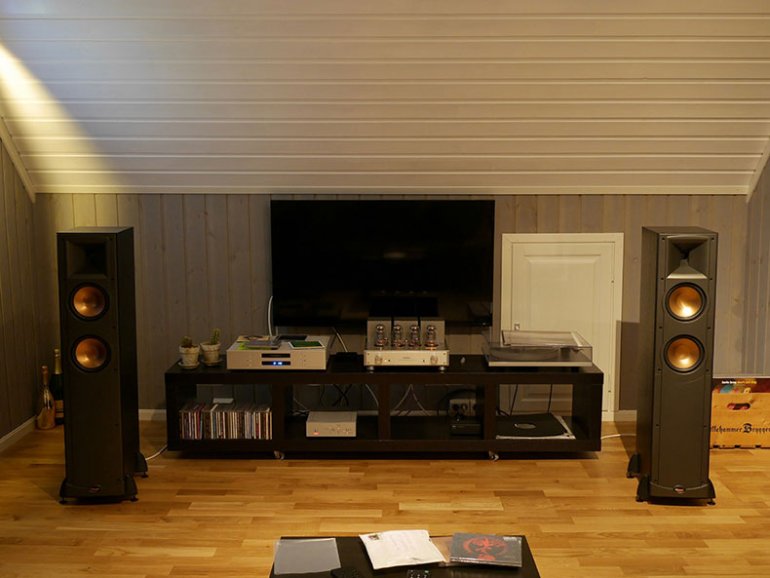
When purchasing separate receiver and separate speaker system you need to make sure they match each other’s power. It’s a bit like weight scales - whatever power your speakers require, the amp should be able to deliver, and without struggle: they should be equally matched. It’s OK if the amp has a bit more wattage than the speaker, but try to avoid the other way round, which may potentially damage your amp! The good news is, if you go with our recommendations above, you won’t actually have to worry about any of this. The amps and the speakers are reasonably well-matched already, so there’s no guesswork involved. But, for the purposes of this article, let’s do a practical example. This example is going to use two concepts: wattage (read, the amount of power something puts out) and impedance (a measure of electrical resistance) Let’s take the $1,499 Denon AVR-X4700H receiver. It’s RMS wattage (the amount of power it puts out over a period of time, as opposed to peak wattage, which is max it can put out in one go - think a jog, versus a sprint) is 165 watts, which is what it’s capable of producing if it meets a set of speakers with eight ohms of electrical resistance.
Matching speakers to this is actually very simple. Every set of speakers will have a recommended amplifier power, which shows the range of power that they can comfortably take. For example, the Fluance Reference Series (which we’ve paired the 838 with in our list) can take amp power of between 80 and 200 watts, while offering eight ohms (8Ω) of electrical resistance.
You will notice that in this case, the ohm levels are matched. In general, this is what you want. Try to avoid matching a set of speakers with a lower nominal impedance to an amplifier that doesn’t offer ratings of that impedance. If you ever do encounter speakers with a higher impedance rating than the amplifier, then go right ahead. You can read more about this in our highly detailed guide to matching amps and speakers.
One of the most common questions we get is from people who want to install ceiling and in-wall speakers in their listening rooms, and want to know the best way to go about it. You'll notice that all the speaker systems on this list are external. That's because we firmly believe that in-wall systems are largely an anachronism. Feel free to debate us on this in the comments, but for the most part, we think you're much better off with separate, individual speakers.
The advantages of in-wall and ceiling speakers, on the one hand, is that they look discrete. You can hide them away, and give your room a sleek, minimalist feel. Problem is, that's about the only advantage. You're essentially sacrificing any advantages a tuned speaker cabinet might give you for the echoing, cavernous space in your walls and ceilings. Even some in-wall speakers which come in small, self-contained cabinets won't sound nearly as good as individual speakers. You also have to actually cut holes to install them (obviously) - which means zero margin for error in placement. And finally, doing it this way means it can be tricky to upgrade later. Our take? Stick to individual speakers. They make so much more sense.
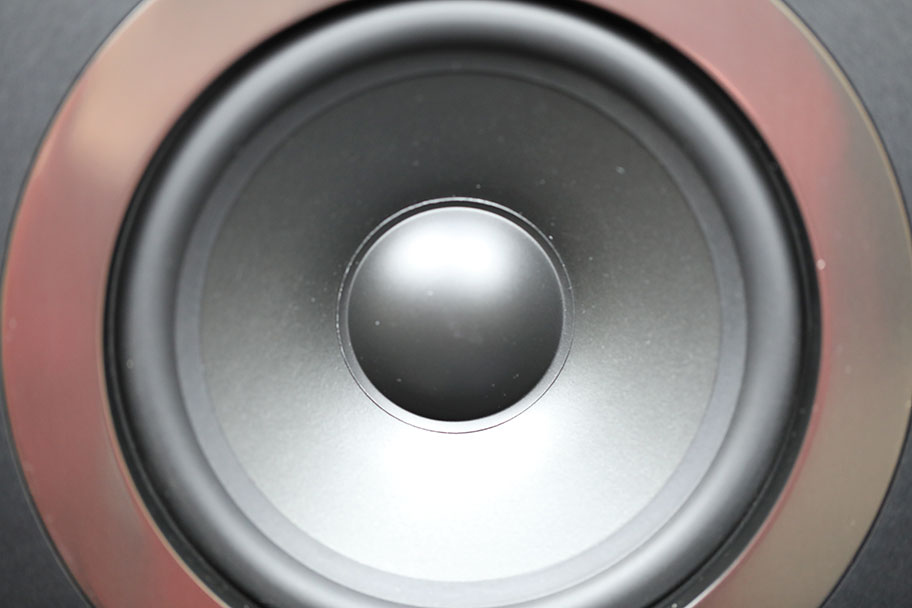
We don’t put a lot of emphasis on frequency ratings here at TMS. For the majority of people, we simply don’t think they are that useful, although you’re more than welcome to fight us in the comments if you disagree. However, when it comes to home theater speakers, we find they can give you a general idea of the range the speakers occupy. A quick primer, if you don’t know what we’re talking about. A frequency measurement is a measurement of the pitch of the sound: how high or how low it is. It’s measured in Hertz (Hz). Humans can hear from roughly 20Hz (a super-low bass note) to 17kHz (a really, really high-pitched finger-on-a-glass-type note. kHz, by the way, means kilohertz, or a thousand hertz - as in, 17,000 Hz).
What we’ve done in our table above is give the lowest frequency of sound that given 7.1 speaker system can offer (usually via its subwoofer) and the highest it can offer via its other speakers. You shouldn’t read too much into this, mostly because these speakers can often generate higher notes that we can actually hear, and it’s annoying when manufacturers emphasize this. But it’s good to know, and in some cases, it can be useful when evaluating speakers.
The most expensive speakers in the world won’t mean a damn thing if you don’t treat your room. That’s because most rooms have walls, and a ceiling, on the floor, and…actually, make that all rooms. If you don’t do anything to them, what those services will do is reflect sound back into the room, absorbing very little. That reflected sound will get together and get dirty, and generally mess up your beautiful surround sound image. To rectify this, you need to add in some acoustic proofing. There are hundreds of solutions out there, and we don’t really have the space to go into them right now, but as a general rule, they take the form of thick foam panels that hang on the walls and ceiling at key points, as well as even thicker bass traps that go in the corners of the room. If you want to see an example, check out this ATS Acoustic Panel, although there are many different flavors of this particular piece of equipment.
We are in the process of putting together a full guide to treating a home theater room. In the meantime, here’s one of the better guides we found, which offers some very neat tricks for getting this done. Follow it, and thank us later.
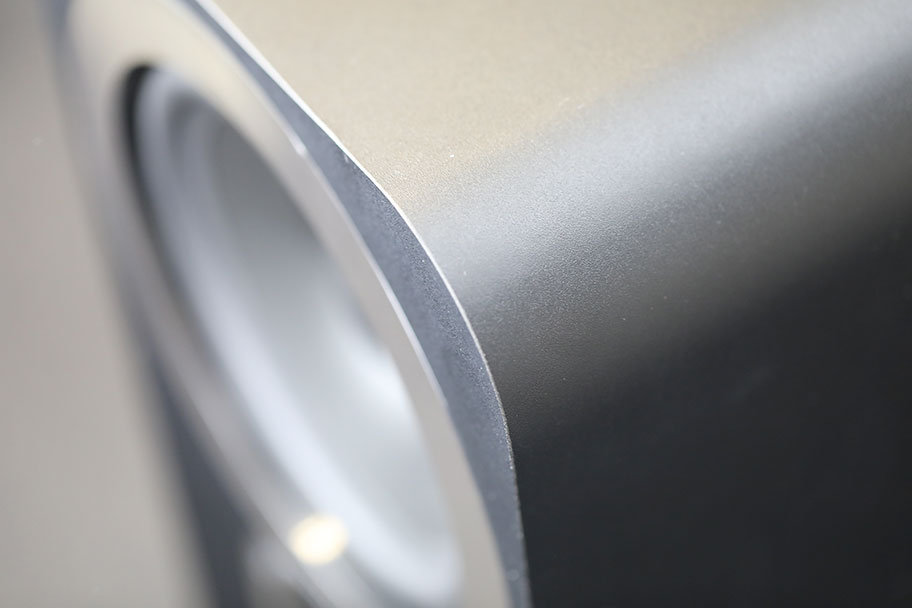
One of the most common questions we get asked is how to use a surround sound system for music. Because on the surface, they aren’t necessarily compatible. Almost all songs are mixed for two channels - left and right. Playing a traditional piece of music in a multichannel system isn’t always easy, and is next to impossible with a stereo mix. Even if you get all seven or nine speakers playing, they’ll most likely just be playing multiple versions of the same channels. You’ll have to go out of your way to find the 5.1 and 7.1 mixes of your favorite albums - if they exist, that is.
However, this may be changing. Recently, PMC did something interesting with the classic album Kind of Blue, by Miles Davis. With the blessing of the Davis estate, who provided the original master tapes, PMC’s engineers created a Dolby Atmos surround sound mix of the album, which they debuted at the Munich High-End audio show. Sadly, we weren’t there to witness it, but we’ve heard that it was ridiculously good.
Unfortunately, right now this kind of experiment is likely to remain just that: an experiment. While the music industry has messed around with four-channel mixes before, back in the 1970s, there is virtually no demand for multichannel original recordings right now. Some film soundtracks are released in 5.1 or 7.1, and every so often an artist will have a stab at it, but it’s exceedingly rare. It’s perfectly possible to play regular music on a surround system, and will almost certainly sound fantastic. But you won’t be getting any more information than you would if you played it out of a standard two-channel hi-fi setup. If you do want to use your surround system for music, we suggest setting your receiver to stereo mode. That way, it will devote all of its power and processing to the front left and front right speakers, giving you the best possible experience.
One of the biggest developments in the world of home theatre is that of 8K video. It’s an improvement on the more standard 4K which packs an even more pixels: 8,192 x 4,320, to be precise. The idea is to grant you a far more detailed and finely grained picture. While most of this piece is to do with audio quality, we do think it’s worth mentioning AK, and talking about whether or not it’s worth investing in. Many AV receivers trumpet their compatibility with it, and we think it’s worth warning you off for the foreseeable future.
That’s down to the fact that this simply isn’t much 8K content available right now, and there won’t be for quite some time. Even the most high definition Blu-ray disc doesn’t boast 8K video, and it’s going to take more than a few years before this happens. One of the most annoying things about the world of home theatre is how manufacturers constantly release new iterations of their products in order to keep pace with changing standards, and so somewhat predictably, this has happened with AV receivers and 8K. For example, the Denon AVR-X3700H receiver is fully compatible with 8K video… Despite the fact that there is very little 8K video to take advantage of.
We would much rather recommend you a slightly more affordable model, if at all possible, and we have done so here. For the time being, be very wary of claiming to offer 8K compatibility stop this may be true, you are essentially paying for something that you cannot take advantage of yet, would be able to do so for quite some time. Unless you are absolutely insistent on future proofing yourself, you can stick with less expensive, older products.